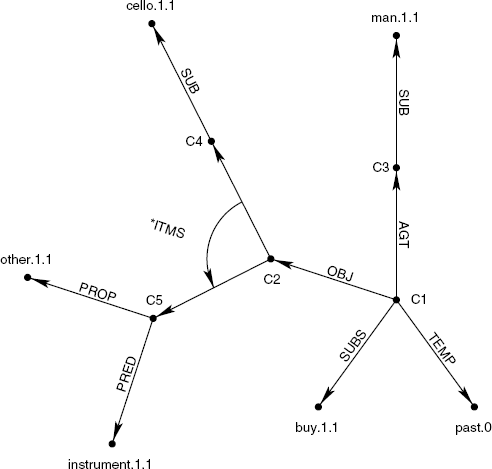11.4 Semantic Networks Following the MultiNet Formalism
The relation extraction described here is based on semantic networks that follow the MultiNet formalism, which was devised by Hermann Helbig [21]. The semantic networks are automatically created by applying a deep syntactico-semantic parser to a text corpus. A semantic network is a graph where the nodes represent concepts and the arcs represent relations between the concepts (or functions involving concepts). Lexicalized concepts correspond to word readings. A lexicalized concept name is given by the lemma and two numbers specifying the homograph and the sememe. For details on the numbering scheme see Ref. [21].
An example of such a semantic network is given in Figure 11.1. The central sentence node, which represents the meaning of the entire sentence, is labeled c1. The actor or agens (MultiNet relation: agt) of the situation expressed by the sentence is a certain man, which is an instance (MultiNet relation sub) of the generic concept man.1.1. The *itms function combines several concepts in a conjunction, in this case the concepts representing the two constituents: cello and other instruments.
Figure 11.1 Example semantic network for the sentence Der Mann kaufte ein Cello und andere Instrumente / “The man bought a cello and other instruments.” For better readability, English concept names are used in the figure.

Sample relations of MultiNet are given below:
- AGT. Conceptual role: agent
- ATTR. Specification of an attribute
- *ITMS. Function enumerating a set
- OBJ. Neutral object
- PRED. Predicative concept characterizing a plurality
- PROP. Relation between object and property
- SUB. Relation of conceptual subordination (hyponymy and instance-of)
- SUB0. Relation of generalized subordination (hyponymy and instance-of), super-relation of sub, subr, and subs
- SUBS. Relation of conceptual subordination for situations (hyponymy, instance-of, and troponymy)
- SUBR. Relation of conceptual subordination for relations
- TEMP. Relation specifying the temporal embedding of a situation
- VAL. Relation between a specific attribute and its value
